Neuroscience (written in 2000)
My neuroscience work has concentrated on simulating and visualizing
the response of ensembles of neurons, using techniques that allow
neurobiologically accurate representations to be computed efficiently.
I have been collaborating with several neurophysiologists
to build real-time visualizations of ensemble auditory responses to sound.
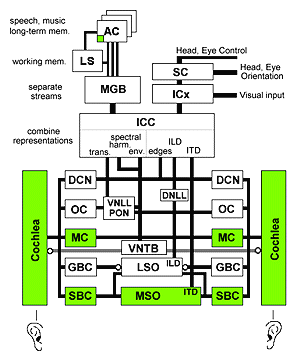
The above diagram shows a highly simplified computational view
of the auditory pathway, emphasizing the auditory brainstem.
The regions marked in green (Cochlea, MC=Multipolar Cells,
SBC=Spherical Bushy Cells, MSO=Medial Superior Olive, AC=Auditory
Cortex) indicate regions for which I have produced movies of
responses. A few stills are shown below.
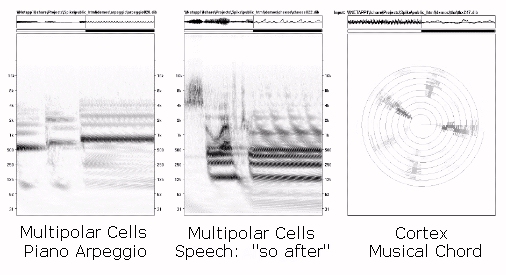
Animations for Collaborators
Several of my neuroscience collaborators have asked for animations
and drawings for use in their introductory lectures.
Permission is granted to use these animations in educational lectures,
as long as the title page with the light-grey link to this site is displayed
and a verbal acknowledgment is given.
Feel free to distribute or send a link to this page to colleagues
who might also want to use them. If you want to incorporate them
in a book/movie/documentary/(anything but a lecture), please
contact me
for written
permission.
I have many other examples, including spatial localization
and familiar music such as
Star Trek, THX movie trailer etc., but the files are very large and
there are copyright issues if I post them on the web.
Buy me a beer and I'll gladly give you a seminar.
Real-Time High-Resolution Cochlear Model
In January, 2000, I built the world's first
high-resolution (240-tap 10-octave) real-time implementation
of a cochlear model using FPGA technology. The figure below shows the immediate
response of a cochlear pressure wave to a piano note.
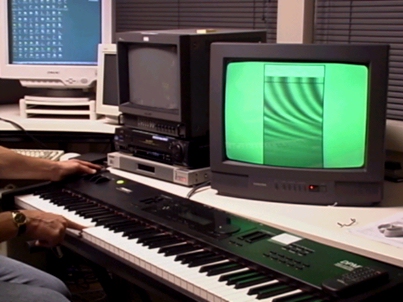
The cochlear model is running in a PC on Interval's custom
supercomputing platform based on Xilinx Field-Programmable Gate Arrays
(FPGAs).

In June 2000, I formed Audience, Inc. (originally known as Applied Neurosystems Corporation) to continue
and commercialize this work.
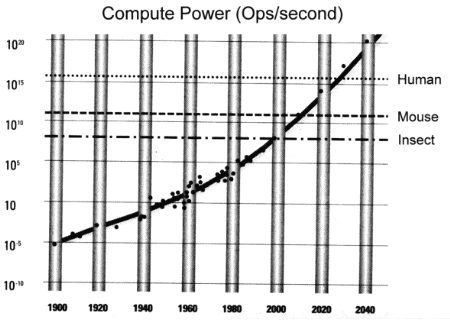
So, why am I working on this?
Here's a figure from Ray Kurzweil's book, The Age of
Spiritual Machines (1999), that is relevant and inspiring. In the
next 10 years, computers will be capable of performing computations fast
enough, and have enough memory, to be able to perform at the level of
a mouse, which is pretty darn good -- mice can
see and hear in stereo, navigate unknown environments, find
food, interact socially, etc.
The hard part for us will be figuring out what algorithms to run on these
amazing computers of 2010. That's why I'm working on reverse engineering
the brain now. In 10 years, the silicon will be ready to do
amazing, brain-like things.
Free Software: Spiking Neuron Simulation
At Caltech, I developed a fast event-driven simulator,
called
Spike,
for simulating large networks of simple spiking neurons.
You can enter your neural circuit graphically or textually, and
view the simulation output logic-analyzer-style, as shown below.

The above circuit is an Adapting Tonic Burster. That is, it has
bursting response based on a tonic input current, and it has an
inhibitory feedback path that causes its firing rate during a burst
to decrease, or adapt. The circuit demonstrates the use of the
summating synapse feature of Spike, which in this case is used to
model a calcium-dependent potassium channel, to create the adapting
behavior.
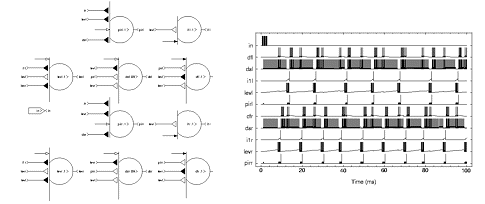
The above circuit is a locust walking circuit developed by Sylvie
Ryckebusch in 1991. This was the first use of Spike to model a real biological
circuit.
|



